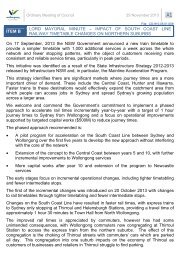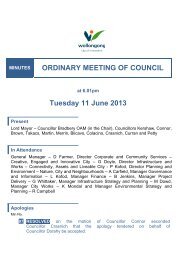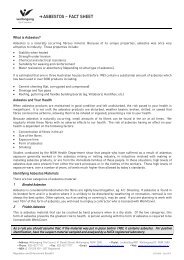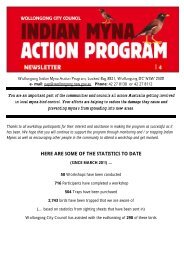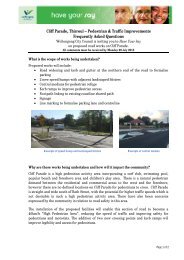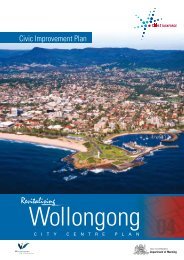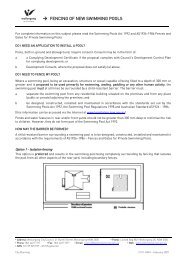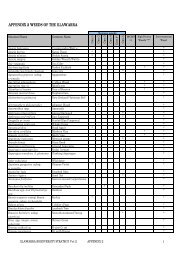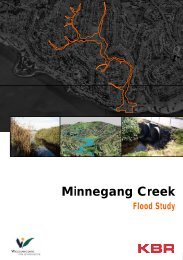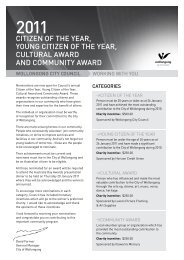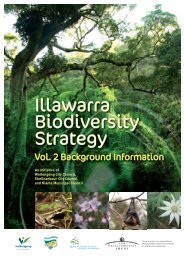Mullet and Brooks Creeks Flood Study Report Part - Wollongong ...
Mullet and Brooks Creeks Flood Study Report Part - Wollongong ...
Mullet and Brooks Creeks Flood Study Report Part - Wollongong ...
Create successful ePaper yourself
Turn your PDF publications into a flip-book with our unique Google optimized e-Paper software.
CALIBRATION AND VERIFICATION 5-62<br />
5.4.3 Topography <strong>and</strong> Structures<br />
Topography <strong>and</strong> structures from the current (2003) DEM <strong>and</strong> structure survey is used as supplied.<br />
That is, no changes to sizes of structures or levels are known to have occurred between 1999 <strong>and</strong><br />
2005 that will impact upon the model’s ability to predict the 1999 flood behaviour.<br />
5.4.4 Culvert <strong>and</strong> Bridge Blockage Assumptions<br />
Blockage assumptions were not applied for the 1999 flood event.<br />
5.4.5 Model Parameters<br />
Hydrologic model parameters adopted for the 1999 event simulation are shown in Table 5-14.<br />
Manning’s n values adopted are shown in Table 5-2.<br />
5.4.6 Downstream Boundary Levels<br />
G:\ADMIN\B14142.G.CLB_MULLETBROOKSFS\R.B14142.001.05.FINAL.DOC<br />
Table 5-14 WBNM Model Parameters – 1999 Calibration<br />
Parameter 1999<br />
% Impervious See Appendix B<br />
Lag Parameter 1.0<br />
Initial Loss - Pervious 60 mm<br />
Continuing Loss Rate – Pervious 2 mm/h<br />
Lake Illawarra level data at Koonawarra was available for the 1999 flood event from a continuous<br />
stage recorder maintained by MHL. Lake levels throughout the flood event are presented in Figure<br />
3-3.<br />
5.4.7 1999 Predicted Flows<br />
Table 5-15 provides predicted flows from the hydraulic model at the listed locations.<br />
Table 5-15 1999 Predicted Flows at Various Locations<br />
Location Flow (m 3 /s)<br />
Freeway F6 Bridge on <strong>Mullet</strong> Creek 239<br />
Princes Highway Bridge on <strong>Mullet</strong> Creek 278<br />
Clevel<strong>and</strong> Road, Dapto 88<br />
Bong Bong Road, Dapto 95<br />
Ena Avenue, Dapto 81<br />
Sheaffes Creek (downstream of West Dapto Road) 30<br />
Robins Creek (Ritchie Crescent) 111<br />
Reed Park Creek (Fairwater Drive) 16<br />
Forest Creek (upstream West Dapto Road) 52
CALIBRATION AND VERIFICATION 5-63<br />
5.4.8 Replication of Recorded Levels<br />
There were no recorded peak flood levels for the 1999 flood event for either <strong>Mullet</strong> Creek or <strong>Brooks</strong><br />
Creek. Continuous gauge recordings are available in both <strong>Mullet</strong> Creek <strong>and</strong> Lake Illawarra. No<br />
gauge recordings are available in <strong>Brooks</strong> Creek.<br />
Figure 5-61 compares the recorded level hydrograph at <strong>Mullet</strong> Creek with the modelled flood level<br />
hydrograph. It is apparent from Figure 5-61 that the model reproduces the peak level well with the<br />
peak modelled level of 4.20 mAHD being within 0.03m of the peak recorded level of 4.17 mAHD.<br />
The timing of the peak is similar, with the recorded peak occurring at 12:15pm <strong>and</strong> the modelled peak<br />
occurring at 12:30pm. In general, the rising limb of the hydrograph is also similar. The falling limb of<br />
the recorded hydrograph is steeper than that of the modelled hydrograph. Matching the slope of the<br />
falling limb was impossible without altering the timing of the rising limb <strong>and</strong> the magnitude of the<br />
peak. It was decided that priority be given to matching of the peak <strong>and</strong> the rising limb.<br />
Some differences in recorded <strong>and</strong> modelled flood levels are also evident at the start <strong>and</strong> end of the<br />
flood. These differences are believed to be related to the weir downstream. A sensitivity analysis on<br />
the downstream weir level shows that for the current surveyed weir level of 0.8 mAHD, the base<br />
water level is approximately 0.9 mAHD at the gauge. If the weir is at 1.1mAHD the base water level<br />
at the gauge is approximately 1.2 mAHD, the base water level recorded by the gauge during the 1999<br />
flood. This could suggest there may have been a blockage downstream of the gauge during the<br />
1999 flood event. The 1999 flood extent for <strong>Mullet</strong> Creek is shown in Figure 5-62.<br />
There were no recorded flood levels in the <strong>Brooks</strong> Creek Catchment for the 1999 flood event. The<br />
flood extent is presented in Figure 5-63.<br />
5.4.9 Conclusions on 1999 Event Calibration<br />
Figure 5-61 demonstrates that the model adequately represents the peak of the flood <strong>and</strong> the timing<br />
of the peak.<br />
G:\ADMIN\B14142.G.CLB_MULLETBROOKSFS\R.B14142.001.05.FINAL.DOC
CALIBRATION AND VERIFICATION 5-64<br />
Level (mAHD)<br />
4.5<br />
4<br />
3.5<br />
3<br />
2.5<br />
2<br />
1.5<br />
1<br />
0.5<br />
0<br />
23/10/199<br />
9 21:36<br />
23/10/199<br />
9 23:36<br />
24/10/199<br />
9 1:36<br />
k:\B14142.k.clb\1999_gauge_comparison_054.xls<br />
24/10/199<br />
9 3:36<br />
24/10/199<br />
9 5:36<br />
24/10/199<br />
9 7:36<br />
G:\ADMIN\B14142.G.CLB_MULLETBROOKSFS\R.B14142.001.05.FINAL.DOC<br />
24/10/199<br />
9 9:36<br />
24/10/199<br />
9 11:36<br />
24/10/199<br />
9 13:36<br />
Time (hrs)<br />
24/10/199<br />
9 15:36<br />
24/10/199<br />
9 17:36<br />
24/10/199<br />
9 19:36<br />
24/10/199<br />
9 21:36<br />
24/10/199<br />
9 23:36<br />
Recorded Gauge Level<br />
Modelled <strong>Flood</strong> Level<br />
Figure 5-61 Comparison between Recorded <strong>and</strong> Modelled Levels at the <strong>Mullet</strong> Creek Gauge<br />
25/10/199<br />
9 1:36<br />
25/10/199<br />
9 3:36<br />
25/10/199<br />
9 5:36
DESIGN EVENT MODELLING – EXISTING CONDITIONS 6-1<br />
6 DESIGN EVENT MODELLING – EXISTING CONDITIONS<br />
6.1 Introduction<br />
The previous chapter of this report details the hydrologic <strong>and</strong> hydraulic modelling of three calibration<br />
events in the <strong>Mullet</strong> Creek catchment. This chapter describes the design event modelling for the<br />
20%, 10%, 5%, 2% <strong>and</strong> 1% AEP flood events <strong>and</strong> the Probable Maximum <strong>Flood</strong> (PMF).<br />
Design floods are hypothetical floods used for planning purposes <strong>and</strong> floodplain management<br />
investigations. They are based on having a probability of occurrence specified either as:<br />
• Annual Exceedance Probability (AEP) expressed as a percentage; or<br />
• An Average Recurrence Interval (ARI) expressed in years.<br />
This report uses the AEP terminology as this is st<strong>and</strong>ard terminology preferred by WCC. Table 6-1<br />
provides a description of the different design floods considered as part of this study.<br />
AEP 1 ARI 2 Comments<br />
G:\ADMIN\B14142.G.CLB_MULLETBROOKSFS\R.B14142.001.05.FINAL.DOC<br />
Table 6-1 Design <strong>Flood</strong> Terminology<br />
1% 100 years A hypothetical flood or combination of floods which<br />
represent the worst case scenario likely to have a 1%<br />
chance of occurring in any one year, or in other words,<br />
is likely to occur once every 100 years on average.<br />
2% 50 years A hypothetical flood or combination of floods which<br />
represent the worst case scenario likely to have a 2%<br />
chance of occurring in any one year, or in other words,<br />
is likely to occur once every 50 years on average.<br />
5% 20 years A hypothetical flood or combination of floods which<br />
represent the worst case scenario likely to have a 5%<br />
chance of occurring in any one year, or in other words,<br />
is likely to occur once every 20 years on average.<br />
10% 10 years A hypothetical flood or combination of floods which<br />
represent the worst case scenario likely to have a 10%<br />
chance of occurring in any one year, or in other words,<br />
is likely to occur once every 10 years on average.<br />
20% 5 years A hypothetical flood or combination of floods which<br />
represent the worst case scenario likely to have a 20%<br />
chance of occurring in any one year, or in other words,<br />
is likely to occur once every 5 years on average.<br />
Extreme <strong>Flood</strong> / PMF 3 A hypothetical flood or combination of floods which<br />
represent an extreme scenario. It is only used for<br />
special purposes (eg. design of a dam spillway) where a<br />
high factor of safety is recommended such as planning<br />
to prevent possible loss of life, or in consideration of<br />
floodplain planning (eg evacuation <strong>and</strong> isolation of<br />
communities).<br />
1 Annual Exceedance Probability (%)<br />
2 Average Recurrence Interval (years)<br />
3 Probable Maximum <strong>Flood</strong>
DESIGN EVENT MODELLING – EXISTING CONDITIONS 6-2<br />
6.2 Design <strong>Flood</strong> Hydrology<br />
The WBNM hydrologic models, developed <strong>and</strong> calibrated for this study, are used to provide inflows to<br />
the hydraulic model for the <strong>Mullet</strong> <strong>and</strong> <strong>Brooks</strong> <strong>Creeks</strong> design events. Details on WBNM model<br />
development are provided in Section 4.2 of this report, <strong>and</strong> the calibration of the hydrologic/hydraulic<br />
model is discussed in Section 5.1.<br />
6.2.1 WBNM Model Parameters<br />
WBNM Lag Parameter (‘C’)<br />
During calibration of the models, a lag factor (C) of 1.0 was found to provide the best calibration. This<br />
value has been maintained for the design event modelling. As discussed in Section 5.1.1, this value<br />
falls outside the recommended values of 1.3 to 1.8. However, due to the steep escarpments within<br />
this catchment, the ‘peaky’ nature of the flow <strong>and</strong> the general ‘down catchment’ movement of storms,<br />
the lower lag factor is physically applicable to the <strong>Mullet</strong>/<strong>Brooks</strong> catchments. Detailed discussion on<br />
the C value is provided in Section 4.2.3 <strong>and</strong> Section 5.1.1.<br />
Continuing Loss<br />
A continuing loss of 2.0mm/hr was found to provide the best calibration for each of the three<br />
calibration events: 1975, 1984 <strong>and</strong> 1999. Thus, a continuing loss of 2.0mm/hr has been maintained<br />
for the design event modelling.<br />
Initial Loss<br />
Initial losses for the calibration events were found to range from 0mm to 60mm. However, the<br />
adopted initial loss for design events should always be 0 mm, regardless of initial losses determined<br />
in calibration. The reasons for this are:<br />
• Initial losses are event specific, being a function of pre-event rainfall <strong>and</strong> not a function of the<br />
catchment;<br />
• Design events are storm bursts. That is, they occur as part of a larger rainfall event, some or all<br />
of the initial loss will be ‘supplied’ by the pre-burst rainfall (Book 6, AR&R, 2001); <strong>and</strong><br />
• To assume an initial loss of 0mm is conservative.<br />
Thus, an initial loss of 0mm is adopted for the design events.<br />
6.2.2 Critical Durations<br />
Assessment of the critical durations for each of the catchments was undertaken using the<br />
hydrologic/hydraulic model. That is, the critical duration was that duration found to provide the<br />
highest peak flood levels as predicted by the hydraulic model. Details on this assessment are<br />
provided in Section 6.3.3. In summary, the critical duration for <strong>Mullet</strong> Creek was found to be a<br />
combination of the 2 hour <strong>and</strong> 6 hour durations while <strong>Brooks</strong> Creek was found to have a critical<br />
duration of 2 hours.<br />
G:\ADMIN\B14142.G.CLB_MULLETBROOKSFS\R.B14142.001.05.FINAL.DOC
DESIGN EVENT MODELLING – EXISTING CONDITIONS 6-3<br />
The critical duration for Lake Illawarra is 36 hours (L&T, 2001). This duration was also simulated for<br />
<strong>Mullet</strong> <strong>and</strong> <strong>Brooks</strong> <strong>Creeks</strong> to provide the highest peak flood levels in the lower portion of each creek.<br />
6.2.3 Design Rainfall Estimation – 20%, 10%, 5%, 2% & 1% AEP<br />
Intensity-Frequency-Duration Parameters<br />
Design rainfall totals were derived for the catchment from Australian Rainfall <strong>and</strong> Runoff (AR&R)<br />
(1987). This is the st<strong>and</strong>ard approach for the development of design hydrographs in Australia.<br />
Design rainfall totals were derived for two locations representing the rainfall intensities across the<br />
<strong>Mullet</strong>/<strong>Brooks</strong> Creek catchments. Figure 6-2 shows the two locations used to derive design event<br />
rainfall, one in the upper catchment <strong>and</strong> one at the catchment outlet to Lake Illawarra. Table 6-2<br />
shows the Intensity-Frequency-Duration (IFD) parameters derived from AR&R (1987) for the two<br />
locations.<br />
G:\ADMIN\B14142.G.CLB_MULLETBROOKSFS\R.B14142.001.05.FINAL.DOC<br />
Table 6-2 Design Rainfall IFD Parameters<br />
IFD Parameter Lower Catchment<br />
(Lake Illawarra)<br />
Location 1 Location 2<br />
Upper Catchment<br />
(Forest Creek)<br />
50% AEP, 1 hour intensity 45 mm/hr 48 mm/hr<br />
50% AEP, 12 hour intensity 9 mm/hr 11 mm/hr<br />
50% AEP, 72 hour intensity 2.75 mm/hr 4 mm/hr<br />
2% AEP, 1 hour intensity 88 mm/hr 110 mm/hr<br />
2% AEP, 12 hour intensity 20 mm/hr 25 mm/hr<br />
2% AEP, 72 hour intensity 6.75 mm/hr 9 mm/hr<br />
Average Regional Skewness 0 0<br />
Design Rainfall Depths<br />
Design rainfall depths for the three durations discussed in Section 6.2.2 (2 hour, 6 hour <strong>and</strong> 36 hour)<br />
are provided in Table 6-3.<br />
Table 6-3 Adopted Design Rainfall Depths<br />
Design Event<br />
AEP<br />
2 hour<br />
Duration<br />
6 hour 36 hour<br />
Location 1 Location 2 Location 1 Location 2 Location 1 Location 2<br />
1% 1570 mm 1995 mm 409 mm 515 mm 217 mm 280 mm<br />
2% 1407 mm 1759 mm 393 mm 454 mm 191 mm 247 mm<br />
5% 1193 mm 1456 mm 305 mm 376 mm 157 mm 205 mm<br />
10% 1031 mm 1231 mm 261 mm 318 mm 132 mm 174 mm<br />
20% 906 mm 1055 mm 226 mm 273 mm 112 mm 149 mm<br />
G:\Admin\B14142.g.gjr\<strong>Report</strong>_Tables_Design.xls<br />
Temporal Distribution of Design Rainfall<br />
The temporal distribution of rainfall is derived from the temporal patterns presented in AR&R (1987).
DESIGN EVENT MODELLING – EXISTING CONDITIONS 6-4<br />
Spatial Distribution of Design Rainfall<br />
The spatial distribution of design rainfall for the 20%, 10%, 5%, 2% <strong>and</strong> 1% AEP events was<br />
determined automatically by the WBNM hydrologic model. The total depth of rainfall in each<br />
subcatchment for each storm is calculated as the weighted depth from all surrounding WBNM<br />
‘raingauges’ (in this case, two locations as shown in Figure 6-2). This weighting is calculated from<br />
the inverse square of the distance between each WBNM ‘raingauge’ <strong>and</strong> the centre of each<br />
subcatchment.<br />
6.2.4 Probable Maximum <strong>Flood</strong><br />
The Probable Maximum <strong>Flood</strong> (PMF) is the largest flood that could reasonably be expected to occur<br />
in a catchment <strong>and</strong> is due to the Probable Maximum Precipitation (PMP). The theoretical definition of<br />
the PMP is “the greatest depth of precipitation for a given duration meteorologically possible for a<br />
given size storm area at a particular location at a particular time of year, with no allowance made for<br />
long-term climatic trends.” (WMO, 1986).<br />
2 hour <strong>and</strong> 6 hour Durations<br />
The 2 hour <strong>and</strong> 6 hour PMP totals, temporal <strong>and</strong> spatial patterns were derived using the Bureau of<br />
Meteorology’s guidelines entitled The Estimation of Probable Maximum Precipitation in Australia:<br />
Generalised Short-Duration Method (BOM, 2003). The Generalised Short-Duration Method (GSDM)<br />
is recommended in AR&R (2001) for PMP estimates for durations of 6 hours or less.<br />
• The 2 hour duration PMP rainfall depth at the centre of the catchment is 510mm.<br />
• The 6 hour duration PMP rainfall depth at the centre of the catchment is 819mm.<br />
The spatial distribution of the PMP for the 2 <strong>and</strong> 6 hour duration events was derived using the GSDM<br />
(BOM, 2003) <strong>and</strong> amendments to this method published in December 1996. This approach is<br />
specific to Australia <strong>and</strong> assumes a stationary storm by distributing the design rainfall across a series<br />
of ellipses that can be orientated in a controlled direction across the catchment. The PMP depth is<br />
allocated in a stepped distribution across the ellipses with all points between consecutive ellipses<br />
having a constant rainfall depth. Figure 6-3 shows the ellipses used in the spatial distribution of the<br />
PMP for <strong>Mullet</strong> <strong>and</strong> <strong>Brooks</strong> <strong>Creeks</strong> catchments <strong>and</strong> the PMP depths for the 2 <strong>and</strong> 6 hour durations.<br />
The temporal distribution of the PMP for the 2 <strong>and</strong> 6 hour duration events was also derived using the<br />
GSDM (BOM, 2003).<br />
The WBNM hydrologic model was run with the estimated PMP depths <strong>and</strong> spatial <strong>and</strong> temporal<br />
patterns derived from BOM (2003) to produce inflow hydrographs for the hydraulic model for the 2<br />
<strong>and</strong> 6 hour PMF events.<br />
36 hour Duration<br />
The BOM (2003) method of PMP estimation is not suitable for durations longer than 6 hours <strong>and</strong> an<br />
alternative method was required to estimate the inflow hydrographs to the hydraulic model for the<br />
36 hour PMF event. To obtain an accurate estimate of the 36 hour duration PMP, AR&R (2001)<br />
suggests the use of a longer duration generalised PMP method. <strong>Wollongong</strong> lies within the<br />
Generalised Southeast Australia Method (GSAM) zone. The GSAM PMP estimation techniques can<br />
G:\ADMIN\B14142.G.CLB_MULLETBROOKSFS\R.B14142.001.05.FINAL.DOC
DESIGN EVENT MODELLING – EXISTING CONDITIONS 6-5<br />
only be undertaken by the Bureau of Meteorology as a fee-based service. PMP estimates provided<br />
by the BoM according to the GSAM are necessary in dam design or other critical areas. However, for<br />
the purposes of this study, it was agreed that a preliminary estimate of the 36 hour PMP depth would<br />
suffice. This preliminary estimate was based on the ratio of the 1% AEP <strong>and</strong> PMP depths calculated<br />
for the 2 hour <strong>and</strong> 6 hour durations. The process is described as follows.<br />
For each subcatchment the ratio between the peak flows of the PMF <strong>and</strong> the 1% AEP flood events<br />
was calculated for the 2 <strong>and</strong> 6 hour durations.<br />
• The average ratio between the 2 hour PMF <strong>and</strong> the 2 hour 1% AEP peak flows for all<br />
subcatchments is 1.62.<br />
• The average ratio between the 6 hour PMF <strong>and</strong> the 6 hour 1% AEP peak flows for all<br />
subcatchments is 1.58.<br />
A factor of 1.60 was therefore applied to the 36 hour 1% AEP inflow hydrographs to estimate the<br />
36 hour PMF hydrographs for input to the hydraulic model. The spatial <strong>and</strong> temporal distribution of<br />
rainfall in this event is therefore the same as for the 1% AEP design event as described above.<br />
6.3 Design <strong>Flood</strong> Hydraulics<br />
6.3.1 Model Geometry<br />
As agreed with Council, the TUFLOW model geometry used for the 1999 calibration event was<br />
adopted for use in the design event modelling with no changes to the model geometry.<br />
6.3.2 Manning’s n<br />
The Manning’s n values used for the design event modelling are unchanged from those used for the<br />
calibration events. These values are used in both the 1D <strong>and</strong> 2D areas of the model. The values<br />
used are shown in Table 6-4. L<strong>and</strong> use category locations are as shown in Figure 6-4 (a<br />
reproduction of Figure 5-2).<br />
G:\ADMIN\B14142.G.CLB_MULLETBROOKSFS\R.B14142.001.05.FINAL.DOC
DESIGN EVENT MODELLING – EXISTING CONDITIONS 6-6<br />
G:\ADMIN\B14142.G.CLB_MULLETBROOKSFS\R.B14142.001.05.FINAL.DOC<br />
Table 6-4 Manning’s ‘n’ for design Event Modelling<br />
Material No. Description<br />
Manning's ‘n’<br />
<strong>Mullet</strong> Ck Catchment <strong>Brooks</strong> Ck Catchment<br />
1 S<strong>and</strong> bed/bank 0.030 0.030<br />
2 Grassy Channels 0.070 0.070<br />
3 Grass (maintained) 0.035 0.035<br />
4 Pasture 0.050 0.050<br />
5 Roads 0.025 0.025<br />
6 Concrete storage areas 0.050 0.050<br />
7 Dense riparian vegetation 0.150 0.150<br />
8 Dense l<strong>and</strong> vegetation 0.150 0.150<br />
9 Creek bed (middle of creek) 0.040 0.040<br />
10 Building 3.000 3.000<br />
11 Urban block 1.000 1.000<br />
12 Concrete in channel 0.050 0.050<br />
13 Dams, open water, bare soil etc 0.060 0.060<br />
14 Lightly vegetated creek 0.080 0.080<br />
15 Dense creek vegetation 0.150 0.150<br />
G:\Admin\B14142.g.gjr\<strong>Report</strong>_Tables_Calibration.xls<br />
6.3.3 Critical Duration<br />
A summary of the critical duration assessments is provided previously in Sections 6.2.2. This section<br />
provides further detail.<br />
To determine the critical duration for the <strong>Mullet</strong> <strong>and</strong> <strong>Brooks</strong> <strong>Creeks</strong> catchments the<br />
hydrologic/hydraulic design models were run for the 1% AEP event for a range of storm durations<br />
between 0.5 <strong>and</strong> 12 hours. The peak water levels for these durations were investigated in order to<br />
determine which duration(s) resulted in the highest peak water levels across the study area.<br />
For <strong>Brooks</strong> Creek, the 2 hour storm duration was found to produce the highest flood levels across the<br />
study area. For <strong>Mullet</strong> Creek, a combination of the 2, 6 <strong>and</strong> 9 hour durations was found to produce<br />
the highest flood levels. The 2 hour storm was critical in the upper parts of the catchment, the 6 hour<br />
storm in the mid-reaches <strong>and</strong> the 9 hour storm in the lower reaches on the downstream side of the<br />
Princes Highway. As peak flood levels in the lower reaches are governed by Lake Illawarra levels it<br />
was decided in agreement with Bewsher Consulting <strong>and</strong> Council that the 2 <strong>and</strong> 6 hour storm<br />
durations would be used to determine the flood envelope for <strong>Mullet</strong> Creek.<br />
In addition, a 36 hour storm duration simulation was also undertaken. In the Lake Illawarra <strong>Flood</strong><br />
<strong>Study</strong> (L&T, 2001) this was found to be the critical duration for the Lake Illawarra catchment (see<br />
Section 6.3.4). The inclusion of the 36 hour creek design event, in conjunction with the 36 hour Lake<br />
Illawarra event, is expected to provide the highest peak flood levels in the lower portions of each<br />
creek.<br />
6.3.4 Downstream Boundary Conditions<br />
Both <strong>Mullet</strong> <strong>and</strong> <strong>Brooks</strong> <strong>Creeks</strong> flow into Lake Illawarra, in the northwest corner of the lake. The<br />
downstream boundary conditions for the hydraulic models of the <strong>Mullet</strong> <strong>and</strong> <strong>Brooks</strong> <strong>Creeks</strong><br />
catchments will therefore be water levels in Lake Illawarra.
DESIGN EVENT MODELLING – EXISTING CONDITIONS 6-7<br />
Lawson <strong>and</strong> Treloar Pty Ltd completed the Lake Illawarra <strong>Flood</strong> <strong>Study</strong> for <strong>Wollongong</strong> City Council,<br />
Shellharbour City Council <strong>and</strong> the Lake Illawarra Authority in July 2001 (L&T, 2001). This study<br />
involved an investigation of flooding of Lake Illawarra to evaluate the current peak flood level<br />
estimates for the 50%, 20%, 10%, 5%, 2% <strong>and</strong> 1% AEP design events <strong>and</strong> the PMF. The 36 hour<br />
storm was found to be the critical duration storm that produced peak lake levels.<br />
For the purposes of this study, the downstream boundary levels of <strong>Mullet</strong> <strong>and</strong> <strong>Brooks</strong> <strong>Creeks</strong> for the<br />
36 hour duration design events have been sourced directly from L&T (2001) model results. However,<br />
the 2 hour <strong>and</strong> 6 hour durations were not simulated by L&T (2001) <strong>and</strong> were required to be simulated<br />
in the model for the purposes of this study. At <strong>Wollongong</strong> City Council’s request, Cardno Lawson<br />
Treloar PTY Ltd (CLT) undertook these simulations for the 20%, 10%, 5%, 2% <strong>and</strong> 1% AEP design<br />
events <strong>and</strong> the PMF.<br />
CLT provided a spreadsheet containing stage time hydrographs for the 20%, 10%, 5%, 2% <strong>and</strong> 1%<br />
AEP events <strong>and</strong> the PMF for the 2, 6 <strong>and</strong> 36 hour durations at three catchment outlet locations on<br />
Lake Illawarra. Council provided this data to BMT WBM via email on 10 January 2006.<br />
The three locations on Lake Illawarra are Macquarie Rivulet, Duck Creek <strong>and</strong> <strong>Mullet</strong> Creek. No direct<br />
time series was available at the exact location of the <strong>Brooks</strong> Creek outlet. A comparison of the stagetime<br />
hydrographs at Macquarie Rivulet (south), Duck Creek (middle) <strong>and</strong> <strong>Mullet</strong> Creek (north)<br />
indicated that there was little variation across that length of Lake Illawarra <strong>and</strong> that therefore it would<br />
be appropriate to use the stage-time hydrograph at the <strong>Mullet</strong> Creek outlet for the <strong>Brooks</strong> Creek<br />
outlet as well. Figure 6-1 shows the stage-time hydrograph on Lake Illawarra used at the <strong>Mullet</strong> <strong>and</strong><br />
<strong>Brooks</strong> <strong>Creeks</strong> outlets for the 1% AEP events for the 2, 6 <strong>and</strong> 36 hour durations. Table 6-5 shows<br />
the peak Lake Illawarra levels at the <strong>Mullet</strong> <strong>and</strong> <strong>Brooks</strong> <strong>Creeks</strong> outlets for all event scenarios<br />
simulated in this flood study.<br />
Level (m AHD)<br />
2.5<br />
2<br />
1.5<br />
1<br />
0.5<br />
0<br />
0 6 12 18 24 30 36<br />
Time (hours)<br />
42 48 54 60 66 72<br />
K:\B14142.k.clb\Tuflow\Boundaries\[Lake Illawarra <strong>Flood</strong> <strong>Study</strong> Stage Hydrographs 10 Jan 2006.xls]<br />
Figure 6-1 Stage Time Hydrograph at <strong>Mullet</strong> <strong>and</strong> <strong>Brooks</strong> <strong>Creeks</strong> Outlets<br />
G:\ADMIN\B14142.G.CLB_MULLETBROOKSFS\R.B14142.001.05.FINAL.DOC<br />
100y 36hr<br />
100y 6hr<br />
100y 2hr
DESIGN EVENT MODELLING – EXISTING CONDITIONS 6-8<br />
Table 6-5 Peak Levels in Lake Illawarra at <strong>Mullet</strong> <strong>and</strong> <strong>Brooks</strong> <strong>Creeks</strong> Outlets<br />
Peak level in Lake Illawarra * (m AHD)<br />
Event (AEP) 2 hour 6 hour 36 hour<br />
PMF 1.89 2.63 3.26<br />
1% 1.18 1.61 2.31<br />
2% 1.09 1.46 2.04<br />
5% 0.95 1.28 1.85<br />
10% 0.86 1.11 1.61<br />
20% 0.79 0.97 1.44<br />
* From Cardno Lawson & Treloar, January 2006.<br />
G:\Admin\B14142.g.gjr\<strong>Report</strong>_Tables_Design.xls<br />
6.3.5 Design Event Combinations<br />
In conjunction with the Technical Working Group (TWG), it was decided to use equivalent creek <strong>and</strong><br />
downstream boundary events to produce the design event combinations.<br />
For each AEP design event three durations were simulated: the 2 hour, 6 hour <strong>and</strong> 36 hour. The<br />
downstream boundary conditions applied at Lake Illawarra were for the same event on the Lake<br />
Illawarra catchment as the <strong>Mullet</strong> <strong>and</strong> <strong>Brooks</strong> <strong>Creeks</strong> catchments. That is, for the 1% AEP 6 hour<br />
design event, the 1% AEP 6 hour storm on the <strong>Mullet</strong> Creek catchment was combined with the stagetime<br />
hydrograph for the 1% AEP 6 hour storm on the Lake Illawarra catchment.<br />
6.4 Culvert <strong>and</strong> Bridge Blockage Assumptions<br />
6.4.1 WCC Blockage Policy<br />
<strong>Wollongong</strong> City Council developed a policy for assumptions regarding blockage of culverts <strong>and</strong><br />
bridges. This policy is presented below:<br />
The following blockage factors are to be applied to structures across all watercourses when<br />
calculating design flood level:<br />
(i) 100% blockage for structures with a major diagonal opening width of less than 6m;<br />
(ii) 25% bottom up blockage for structures with a major diagonal opening width of greater<br />
than 6m. For bridge structures involving piers or bracing, the major diagonal length is<br />
defined as the clear diagonal opening between piers/bracing, not the width of the<br />
channel at the cross-section;<br />
(iii) 100% blockage for h<strong>and</strong>rails over structures covered in (i) <strong>and</strong> for structures covered<br />
in (ii) when overtopping occurs.<br />
This policy is open to interpretation in relation to the treatment of blocking bridge openings described<br />
in (ii) above. If the major diagonal length is less than 6m in a single span, the question remains if that<br />
requires a 25% blockage of that particular span or the entire bridge. It was decided in conjunction<br />
with Council that if a single span is greater than 6m then a 25% blockage would be applied to all<br />
spans of the bridge.<br />
G:\ADMIN\B14142.G.CLB_MULLETBROOKSFS\R.B14142.001.05.FINAL.DOC
DESIGN EVENT MODELLING – EXISTING CONDITIONS 6-9<br />
It was decided in conjunction with Council that three blockage scenarios would be undertaken for<br />
<strong>Mullet</strong> <strong>and</strong> <strong>Brooks</strong> <strong>Creeks</strong>. These scenarios were considered to cover the worst possible case for<br />
each AEP design event. The cases are discussed below <strong>and</strong> shown in Figure 6-5.<br />
• Case 0: All culverts <strong>and</strong> bridges fully open.<br />
• Case 1: All culverts <strong>and</strong> bridges blocked either 100% or 25% blocked depending on diagonal<br />
opening span according to Council policy.<br />
• Case 2: <strong>Part</strong>ially blocked case. This case was developed following a review of the Case 0 <strong>and</strong><br />
Case 1 results in order to develop a scenario that might result in higher peak flood levels in some<br />
locations by keeping some culverts <strong>and</strong> bridges blocked whilst opening others. The structures to<br />
be opened were chosen by assessing the impacts of fully blocking all culverts compared to the<br />
unblocked cases. The culverts chosen to unblock for Case 2 were those for which blocking<br />
resulted in the more significant impacts on peak water levels compared to the unblocked case.<br />
In particular, it was expected that blocking the F6 Freeway bridge but fully opening the Princes<br />
Highway bridge would result in higher peak flood levels on the floodplain upstream of the<br />
Freeway. In this scenario, all bridges <strong>and</strong> culverts are considered to be blocked according the<br />
blockage policy with the exception of the following, which are considered to be open:<br />
Culvert MC14_0050_R which runs underneath Avondale Colliery Road in the south of the<br />
catchment;<br />
Culverts MC30_0120_C <strong>and</strong> MC30_0100_C under Homestead Drive <strong>and</strong> Horsley Drive in<br />
Horsley;<br />
Culverts RC10_0150_C under Shone Avenue in Horsley;<br />
Culverts RC22_0020_C, RC21_0020_R <strong>and</strong> bridge RC21_0030_B at West Dapto road in<br />
Wongawilli;<br />
Bridges MC10_0200_B <strong>and</strong> MC10_0180_B where <strong>Mullet</strong> Creek flows underneath the<br />
Princes Highway;<br />
Culverts RW1_0510_C, RW10_0410_R, RW10_0310_C, GC10_0060_C, GC10_0040_Cd<br />
<strong>and</strong> GC10_0030_R under the railway line <strong>and</strong> Princes Highway at the northern extent of the<br />
study area; <strong>and</strong><br />
Culverts BC10_0610_R, BC10_0410_R <strong>and</strong> BC10_0310_R on <strong>Brooks</strong> Creek underneath<br />
Emerson Road, Fowlers Road <strong>and</strong> Byamee Street respectively.<br />
The location of the open bridges <strong>and</strong> culverts is shown in Figure 6-5.<br />
In all three design cases (Case 0, Case 1, Case 2) the h<strong>and</strong>rails were assumed to be fully blocked.<br />
G:\ADMIN\B14142.G.CLB_MULLETBROOKSFS\R.B14142.001.05.FINAL.DOC
DESIGN EVENT RESULTS – EXISTING CONDITIONS 7-1<br />
7 DESIGN EVENT RESULTS – EXISTING CONDITIONS<br />
7.1 Interpretation of Results<br />
7.1.1 General Issues<br />
The interpretation of the maps <strong>and</strong> other presentations in this report should be done so with an<br />
appreciation of any limitations in their accuracy. The accuracy of the predicted flood flows, levels <strong>and</strong><br />
extents in this flood study is dependent on the accuracy of the data used to develop the hydrologic<br />
<strong>and</strong> hydraulic models <strong>and</strong> the ability of the models to represent the behaviour of the catchment during<br />
a storm event. While the points below highlight these limitations, it is important to note that the<br />
results presented provide an up-to-date, reliable <strong>and</strong> accurate prediction of design flood behaviour.<br />
Points to remember are:<br />
• Recognition that no two actual floods behave in exactly the same manner;<br />
• Design floods are a best estimate of an ‘average’ flood for their probability of occurrence;<br />
• The DEM has been generated from photogrammetry supplied to BMT WBM in August 2003. As<br />
flood depths <strong>and</strong> flood extents are determined using the DEM, their accuracy should be<br />
interpreted accordingly; <strong>and</strong>.<br />
• Approximations are used to represent the PMF event (refer to Section 6.2.4).<br />
7.1.2 Uncertainty in Design <strong>Flood</strong> Results<br />
All design floods are based on statistical analyses of recorded rainfall data. The longer the period of<br />
recordings, the greater the certainty. For example, derivation of the 1% AEP event rainfall from 5<br />
years of recordings would have a much greater error margin than from 100 years of recordings.<br />
Similarly, the accuracy of the hydrologic <strong>and</strong> hydraulic computer models is dependent on the amount<br />
<strong>and</strong> range of reliable rainfall <strong>and</strong> flood level recordings for model calibration. The results of an uncalibrated<br />
model have a greater error margin than a calibrated model.<br />
The error margin in this study is regarded as moderate due to:<br />
• A reasonable amount of rainfall <strong>and</strong> flood level data;<br />
• Calibration <strong>and</strong> verification of the flood models to three historical events;<br />
• Uncertainties associated with data used to develop the DEM (see below); <strong>and</strong><br />
• Approximations used for the PMF event.<br />
In this hydrologic/hydraulic model the main source of inaccuracy is within the topographic data. The<br />
topographic data used in this model was collected by photogrammetry <strong>and</strong> ground survey (see<br />
Section 3.1). The DEM was checked against eight ground survey sections. The channel crosssections<br />
within the 1D areas of the model are derived from cross-sections extracted from the DEM<br />
(see Section 4.3.2). The accuracy of the model predictions in this flood study would be improved if<br />
surveyed channel sections were available, particularly along the many reaches where the channel is<br />
G:\ADMIN\B14142.G.CLB_MULLETBROOKSFS\R.B14142.001.05.FINAL.DOC
DESIGN EVENT RESULTS – EXISTING CONDITIONS 7-2<br />
overgrown with vegetation <strong>and</strong> photogrammetry methods may not have been able to capture the true<br />
ground surface.<br />
One area of particular concern is in the most upstream reaches of the <strong>Mullet</strong> <strong>and</strong> <strong>Brooks</strong> <strong>Creeks</strong><br />
catchments where the flow appears to be mostly contained within the creek channel. Here, the inbank<br />
areas of the creek cross-sections are important in determining flows/levels <strong>and</strong>, as these crosssections<br />
have been extracted from the DEM, the accuracy of these in-bank areas may not be high.<br />
It should be recognised that the model has been developed with the best data available at the time of<br />
development.<br />
7.1.3 Definition of Peak<br />
Unless otherwise stated, presentations in this report are based on peak values of flood level <strong>and</strong><br />
flows. The peak flood level does not occur everywhere at the same time <strong>and</strong>, therefore, the values<br />
presented are based on taking the maximum which occurred at each computational point in the<br />
model during the entire flood. Hence, a presentation of peak levels does not represent an<br />
instantaneous point in time, but rather an envelope of the maximum values that occurred over the<br />
duration of the flood event.<br />
7.1.4 Terminology<br />
The following terms are used to describe the flood model results.<br />
Velocity<br />
Velocity is defined as the speed at which the floodwaters are moving. Typically, modelled velocities<br />
in a creek or river are quoted as the depth <strong>and</strong> width averaged velocity, i.e. the average velocity<br />
across the whole river or creek section if one-dimensional model is used; <strong>and</strong> depth average if a twodimensional<br />
model is used. It is worth noting that velocities can be significantly higher than the<br />
figures quoted at some locations due to localised effects (eg in channel areas or outside bends).<br />
Water Level/<strong>Flood</strong> Level<br />
The flood level or water level is the height or elevation of floodwaters relative to a datum (typically the<br />
Australian Height Datum).<br />
Depth<br />
The water depth (m) is the height or elevation of floodwaters above ground level. This should not be<br />
confused with water level which is the height of the water relative to a datum (not ground level).<br />
7.2 Design <strong>Flood</strong> Behaviour – Summary<br />
7.2.1 <strong>Flood</strong> Mapping of Design <strong>Flood</strong> Behaviour<br />
The flood mapping presented in this report is a maximum flood envelope. For each AEP design<br />
event on <strong>Mullet</strong> Creek, the flood envelope is the maximum flood level from nine simulations (three<br />
durations: 2 hour, 6 hour <strong>and</strong> 36 hour <strong>and</strong> three blockage cases: Case 0, Case 1 <strong>and</strong> Case 2). For<br />
G:\ADMIN\B14142.G.CLB_MULLETBROOKSFS\R.B14142.001.05.FINAL.DOC
DESIGN EVENT RESULTS – EXISTING CONDITIONS 7-3<br />
<strong>Brooks</strong> Creek the flood envelope is the maximum of six simulations (two durations: 2 hour <strong>and</strong><br />
36 hour <strong>and</strong> three blockage cases: Case 0, Case 1 <strong>and</strong> Case 2).<br />
Figure 7-2 shows the predicted flood envelope for the 1% AEP design event. The figure shows<br />
coloured depth contours <strong>and</strong> labelled peak flood level contours. Note that in the <strong>Mullet</strong> Creek<br />
catchment, there is a low-lying area in the Reed Creek floodplain with complex floodplain interactions<br />
between two waterways (marked with blue-hatching in Sheet 2 of Figure 7-2 to 7-7). These<br />
waterways have been approximated using a 1D modelling approach. <strong>Flood</strong> levels <strong>and</strong> depths should<br />
be considered indicative only in this area.<br />
It should be noted that the actual exceedance probability of the modelled flood shown in Figure 7-2 is<br />
less than 1% as it depends on a particular combination of 1% AEP design storms on the <strong>Mullet</strong><br />
Creek, <strong>Brooks</strong> Creek <strong>and</strong> Lake Illawarra catchments together with a particular blockage scenario.<br />
<strong>Flood</strong> envelopes for the 20%, 10%, 5% <strong>and</strong> 2% AEP <strong>and</strong> PMF flood events are shown in Figure 7-3<br />
to Figure 7-7. Similarly, the actual recurrence intervals for these floods as they appear in the figures<br />
are greater than that with which they are labelled.<br />
7.2.2 Peak <strong>Flood</strong> Levels at Selected Locations<br />
Table 7-1 shows the modelled peak flood levels for the 1% AEP design event at selected locations for<br />
the unblocked case for the 2, 6 <strong>and</strong> 36 hour durations. The duration that produces the highest<br />
predicted flood levels for each location is highlighted in bold. The flood behaviour at these nine<br />
locations will be discussed in more detail in Section 7.3.2.<br />
Table 7-1 Peak Levels for the 1% AEP Design Event at Selected Locations (Case 0)<br />
Location<br />
Peak 1% AEP <strong>Flood</strong> Level (m AHD)<br />
2 hour 6 hour 36 hour<br />
Freeway F6 Bridge on <strong>Mullet</strong> Creek 3.58 3.90 3.96<br />
Princes Highway Bridge on <strong>Mullet</strong> Creek 5.32 5.55 5.44<br />
Clevel<strong>and</strong> Road, Dapto 15.56 15.57 15.43<br />
Bong Bong Road, Dapto 10.86 10.89 10.76<br />
Ena Avenue, Dapto 21.14 21.04 20.55<br />
Sheaffes Creek (d/s of West Dapto Road) 8.13 7.93 7.64<br />
Robins Creek (Ritchie Crescent) 12.54 12.46 12.02<br />
Reed Park Creek (Fairwater Drive) 14.75 14.81 14.79<br />
Forest Creek (u/s of West Dapto Road) 14.00 13.96 10.62<br />
G:\Admin\B14142.g.gjr\<strong>Report</strong>_Tables_Design.xls<br />
Predicted peak flood levels for the 1% AEP design event at all 1D nodes are shown in Appendix F.<br />
Table 7-2 shows the modelled peak flood levels at the same locations for the 1%, 2%, 5%, 10% <strong>and</strong><br />
20% AEP <strong>and</strong> the PMF design flood events. The modelled flood levels shown are the maximum<br />
flood level from the three durations for each design event in the unblocked case.<br />
G:\ADMIN\B14142.G.CLB_MULLETBROOKSFS\R.B14142.001.05.FINAL.DOC
DESIGN EVENT RESULTS – EXISTING CONDITIONS 7-4<br />
Location<br />
Table 7-2 Peak <strong>Flood</strong> Levels for a Range of Design Events at Selected Locations (Case 0)<br />
G:\ADMIN\B14142.G.CLB_MULLETBROOKSFS\R.B14142.001.05.FINAL.DOC<br />
Peak <strong>Flood</strong> Level (m AHD) for Design Events (AEP)<br />
PMF 1% 2% 5% 10% 20%<br />
Freeway F6 Bridge on <strong>Mullet</strong> Creek 5.95 3.96 3.78 3.61 3.40 3.22<br />
Princes Highway Bridge on <strong>Mullet</strong> Creek 7.22 5.55 5.33 5.07 4.84 4.65<br />
Clevel<strong>and</strong> Road, Dapto 16.19 15.57 15.51 15.42 15.33 15.25<br />
Bong Bong Road, Dapto 11.59 10.89 10.82 10.68 10.51 10.40<br />
Ena Avenue, Dapto 22.17 21.14 20.88 20.59 20.31 20.07<br />
Sheaffes Creek (d/s of West Dapto Road) 8.77 8.13 7.98 7.84 7.73 7.60<br />
Robins Creek (Ritchie Crescent) 14.53 12.54 12.29 11.99 11.75 11.52<br />
Reed Park Creek (Fairwater Drive) 15.71 14.81 14.74 14.70 14.65 14.60<br />
Forest Creek (u/s of West Dapto Road) 15.54 14.00 13.87 13.67 13.50 13.36<br />
G:\Admin\B14142.g.gjr\<strong>Report</strong>_Tables_Design.xls<br />
7.2.3 Peak Flows at Selected Locations<br />
Table 7-3 shows the predicted 1% AEP flows at selected locations for the unblocked case for the 2, 6<br />
<strong>and</strong> 36 hour durations. The duration with the highest flows for each location is highlighted in bold.<br />
The flood behaviour at these nine locations will be discussed in more detail in Section 7.3.2.<br />
Table 7-3 Peak Flows for the 1% AEP Design Event at Selected Locations (Case 0)<br />
Peak 1% AEP Flow (m 3 Location<br />
/s)<br />
2 hour 6 hour 36 hour<br />
Freeway F6 Bridge on <strong>Mullet</strong> Creek 585 769 806*<br />
Princes Highway Bridge on <strong>Mullet</strong> Creek 640 733 664<br />
Clevel<strong>and</strong> Road, Dapto 348 348 252<br />
Bong Bong Road, Dapto 396 409 317<br />
Ena Avenue, Dapto 356 341 243<br />
Sheaffes Creek (d/s of West Dapto Road) 117 89 55<br />
Robins Creek (Ritchie Crescent) 479 456 338<br />
Reed Park Crescent (Fairwater Drive) 41 46 46<br />
Forest Creek (u/s of West Dapto Road) 183 169 122<br />
Note: All flows are the total 1D <strong>and</strong> 2D flow at each location<br />
* There is a significant head drop across the F6 Freeway in the 36 hour event with high predicted water levels in the storage area<br />
between the Princes Highway <strong>and</strong> the F6 Freeway.<br />
G:\Admin\B14142.g.gjr\<strong>Report</strong>_Tables_Design.xls<br />
Predicted peak flows for the 1% AEP design event at all 1D channels are presented in Appendix F. It<br />
should be noted that in some places the flows presented in Appendix F appear to decrease moving<br />
downstream through the catchment, this is where flow has broken out of the 1D channel onto the 2D<br />
floodplain.<br />
Table 7-4 below shows the predicted peak flows at the same locations for the 1%, 2%, 5%, 10% <strong>and</strong><br />
20% AEP design flood events. The flows shown are the maximum flow from the three durations for<br />
each AEP in the unblocked case.
DESIGN EVENT RESULTS – EXISTING CONDITIONS 7-5<br />
Location<br />
Table 7-4 Peak Flows for a Range of Design Events at Selected Locations (Case 0)<br />
G:\ADMIN\B14142.G.CLB_MULLETBROOKSFS\R.B14142.001.05.FINAL.DOC<br />
Peak Flows (m 3 /s) for Design Events (AEP)<br />
PMF 1% 2% 5% 10% 20%<br />
Freeway F6 Bridge on <strong>Mullet</strong> Creek 2057 806 691 600 496 414<br />
Princes Highway Bridge on <strong>Mullet</strong> Creek 1474 733 638 535 458 392<br />
Clevel<strong>and</strong> Road, Dapto 972 348 299 248 197 163<br />
Bong Bong Road, Dapto 1218 409 348 280 218 179<br />
Ena Avenue, Dapto 912 356 309 252 201 166<br />
Sheaffes Creek (d/s of West Dapto Road) 224 117 99 79 64 52<br />
Robins Creek (Ritchie Crescent) 1139 479 410 333 275 228<br />
Reed Park Crescent (Fairwater Drive) 214 46 40 34 28 23<br />
Forest Creek (u/s of West Dapto Road) 376 183 157 129 107 89<br />
Note: All flows are the total 1D <strong>and</strong> 2D flow at each location<br />
G:\Admin\B14142.g.gjr\<strong>Report</strong>_Tables_Design.xls<br />
7.2.4 Peak <strong>Flood</strong> Level Profiles<br />
Longitudinal flood level profiles for <strong>Mullet</strong> <strong>and</strong> <strong>Brooks</strong> <strong>Creeks</strong> for the 20%, 10%, 5%, 2% <strong>and</strong> 1% AEP<br />
<strong>and</strong> PMF design flood events are shown in Figure 7-9 <strong>and</strong> Figure 7-10. Profile locations are shown in<br />
Figure 7-8. The predicted peak flood level profiles shown are the maximum flood level for each AEP.<br />
For <strong>Mullet</strong> Creek, this is the maximum flood level from nine simulations (three durations <strong>and</strong> three<br />
blockage cases). For <strong>Brooks</strong> Creek, the profile is the maximum flood level from six simulations (two<br />
durations <strong>and</strong> three blockage cases).<br />
7.2.5 Provisional Hazard Categories<br />
Provisional hazards are calculated according to the criteria provided in the NSW <strong>Flood</strong>plain<br />
Development Manual (NSWG, 2005) Figure L2, reproduced here as Figure 7-1.<br />
NSW <strong>Flood</strong>plain Development Manual (NSWG, 2005) Figure L2<br />
Figure 7-1 Provisional Hazard Categories
DESIGN EVENT RESULTS – EXISTING CONDITIONS 7-6<br />
High hazard is defined as representing:<br />
• possible danger to personal safety,<br />
• evacuation by trucks difficult,<br />
• able-bodied adults would have difficulty wading to safety, <strong>and</strong><br />
• potential for significant structural damage to buildings.<br />
Low hazard is defined as representing:<br />
• trucks can evacuate people <strong>and</strong> possessions if necessary, <strong>and</strong><br />
• able-bodied adults would have little difficulty wading to safety.<br />
Hazards are mapped according to these criteria for <strong>Mullet</strong> <strong>and</strong> <strong>Brooks</strong> <strong>Creeks</strong> in Figure 7-11. For<br />
areas that are represented in 1D, the hazard is taken as the maximum hazard along each 1D crosssection<br />
to provide a conservative approach.<br />
7.3 Design <strong>Flood</strong> Behaviour – <strong>Mullet</strong> Creek<br />
7.3.1 General Discussion<br />
General Behaviour<br />
Model results indicate that, in general, the flood behaviour of <strong>Mullet</strong> Creek is not complex. In the<br />
upper reaches of the catchment model results show that flow is relatively contained within the<br />
channel <strong>and</strong> a narrow floodplain in the 1% AEP design event.<br />
In the middle <strong>and</strong> lower reaches of the <strong>Mullet</strong> Creek catchment, where the channels become more<br />
overgrown <strong>and</strong> me<strong>and</strong>ering, model results indicate that out of bank flow becomes more significant.<br />
Upstream of the Princes Highway, where flood water backs up behind the crossing, peak flood<br />
depths greater than 1.5m are predicted in the 1% AEP design event. The predicted velocities of this<br />
floodplain flow are generally between 1.0 <strong>and</strong> 1.5m/s during the 1% AEP design event but there are<br />
locations where out of bank velocities are predicted to be greater than 2.0m/s.<br />
There is an extensive floodplain area between the Princes Highway <strong>and</strong> the F6 Freeway that is<br />
predicted to cover both the golf course <strong>and</strong> racecourse. In this floodplain area model results indicate<br />
inundation depths greater than 1.5m in the 1% AEP design event.<br />
Downstream of the F6 Freeway there is a northern <strong>and</strong> a southern outlet to Lake Illawarra. Model<br />
results indicate that the principal flow route to the southern outlet is via the main channel of <strong>Mullet</strong><br />
Creek. <strong>Flood</strong> water is predicted to reach the northern outlet via the Tank Trap Channel, Hooka Creek<br />
<strong>and</strong> overl<strong>and</strong> through the park. A greater proportion of flow leaves the catchment through this<br />
northern outlet than via the main <strong>Mullet</strong> Creek channel to the southern outlet. Inundation depths<br />
downstream of the F6 Freeway are predicted to be greater than 1.5m in parts of the park <strong>and</strong><br />
memorial gardens but are generally shallower with predicted depths from 0 to 1m in the 1% AEP<br />
design event. Predicted overl<strong>and</strong> velocities in this area are less than 1.0m/s.<br />
G:\ADMIN\B14142.G.CLB_MULLETBROOKSFS\R.B14142.001.05.FINAL.DOC
DESIGN EVENT RESULTS – EXISTING CONDITIONS 7-7<br />
Throughout the <strong>Mullet</strong> Creek catchment there are many small bridge <strong>and</strong> culvert structures. The<br />
major constrictions on flow within this study area are the crossings of the Princes Highway <strong>and</strong> F6<br />
Freeway. <strong>Flood</strong> water is predicted to back up behind these constrictions in all design events<br />
modelled as part of this study. Model results indicate that these major crossings will not be<br />
overtopped in a 1% AEP design event. In the longer duration events there is significant storage of<br />
flood water in the area between the Princes Highway <strong>and</strong> the F6 Freeway.<br />
Darkes Road, West Dapto Road <strong>and</strong> Bong Bong Road are all predicted to be overtopped in sections<br />
during the 1% AEP design event. Some sections of these roads are also overtopped in the more<br />
frequent design flood events. Consequently, there is a risk of West Dapto becoming inaccessible if<br />
significant overtopping of these roads occurred as predicted during a major flood event. This risk is<br />
increased by the potential blockage of the structures under these roads.<br />
1% AEP Event<br />
In the steep upper parts of the catchment, the predicted peak flood levels are due to the 2 hour<br />
duration events in the 1% AEP design event. The peak levels are derived from a combination of the<br />
Case 0, Case 1 <strong>and</strong> Case 2 blockage scenarios. In the mid reaches of the catchment, between<br />
Horsley <strong>and</strong> the Princes Highway, the 1% AEP peak flood levels are predicted to be due to the 6 hour<br />
duration event with Case 1 or Case 2 blockages. Downstream of the F6 Freeway the longer duration<br />
36 hour event (with Case 1 or Case 2 blockages) results in the highest predicted peak flood levels<br />
because of the dominating influence of the downstream boundary at Lake Illawarra. In the high<br />
volume event (36 hour duration) the area between the Princes Highway <strong>and</strong> F6 Freeway acts as a<br />
large storage area with high predicted peak flood levels.<br />
The predicted flood extent for the 1% AEP design event shown in Figure 7-6 has been compared to<br />
the actual flood extent for the 1984 calibration event (provided by Council) <strong>and</strong> the modelled flood<br />
extent for the 1984 calibration event presented in this study (Figure 5-53). The modelled flood extent<br />
for the 1% AEP design event is predicted to be smaller than that of the actual <strong>and</strong> modelled February<br />
1984 calibration event. The February 1984 flood event was estimated to have an average recurrence<br />
interval greater than 500 years (WM, 1997).<br />
The predicted flood extent for the 1% AEP design event was also compared to the modelled flood<br />
extents for the March 1975 <strong>and</strong> October 1999 calibration events (Figure 5-26 <strong>and</strong> Figure 5-62). The<br />
modelled extent for the 1% AEP design event is more extensive than the modelled extent of both<br />
these calibration events. The 1% AEP design event flows in Table 7-3 can be compared to the<br />
calibration flows in Table 5-6, Table 5-10 <strong>and</strong> Table 5-15. This shows that the flows from both the<br />
1975 <strong>and</strong> 1999 calibration events are lower than the 1% AEP design event flows. The 1984<br />
calibration event flows are higher than the predicted 1% AEP design flows in Table 7-3.<br />
The modelled extent for the 1% AEP design event shown in Figure 7-6 has also been compared to<br />
the results of previous studies (WM, 1997). See Section 7.3.3 for further discussion.<br />
Other Events<br />
In the more frequent flood events (5%, 10% <strong>and</strong> 20% AEP design events) the influence of levels in<br />
Lake Illawarra is predicted to extend further upstream with peak levels in the floodplain on the<br />
upstream side of the Princes Highway resulting from the 36 hour duration scenarios.<br />
G:\ADMIN\B14142.G.CLB_MULLETBROOKSFS\R.B14142.001.05.FINAL.DOC
DESIGN EVENT RESULTS – EXISTING CONDITIONS 7-8<br />
In the PMF flood event model results indicate less influence of Lake Illawarra levels on peak flood<br />
levels in the <strong>Mullet</strong> Creek catchment. In the PMF flood event the predicted peak flood levels in the<br />
upper <strong>and</strong> middle parts of the catchment, as far downstream as the Princes Highway, are due to the<br />
2 hour duration events <strong>and</strong> a combination of the Case 0, Case 1 <strong>and</strong> Case 2 blockage scenarios.<br />
Between the Princes Highway <strong>and</strong> the F6 Freeway the 6 hour duration event with Case 2 blockages<br />
is predicted to result in the highest peak flood levels. Downstream of the F6 Freeway model results<br />
show a combination of the 6 hour duration events with Case 0 <strong>and</strong> Case 2 blockage causing the<br />
highest peak flood levels, with the 36 hour duration event (with Case 2 blockages) causing the<br />
highest predicted peak flood levels in a small area around the shore of Lake Illawarra.<br />
7.3.2 Detailed Discussion<br />
Several areas of the <strong>Mullet</strong> Creek catchment have been highlighted by Council as being of particular<br />
significance in this flood study. The modelled peak flood levels <strong>and</strong> flows at these locations are<br />
included in Table 7-1 to Table 7-4. The predicted flood behaviour at these specific areas of interest<br />
will be discussed in this section, primarily focussing on the 1% AEP design event. It should be noted<br />
that throughout this discussion the left <strong>and</strong> right creek banks are defined as though looking<br />
downstream <strong>and</strong> the discussion progresses from the upper reaches of the catchment downstream to<br />
Lake Illawarra.<br />
Near Ena Avenue, overl<strong>and</strong> flow is predicted to occur on both sides of <strong>Mullet</strong> Creek during the 1%<br />
AEP design flood event. A significant proportion of the total flow at this point is predicted to be on the<br />
floodplain with velocities up to 2m/s <strong>and</strong> some flow into the back gardens of properties along this<br />
road. The peak flows <strong>and</strong> levels in the 1% AEP design flood at Ena Avenue occur during the 2 hour<br />
event with no blockages. It is important to note that a separate, more detailed, study has been<br />
undertaken for the Ena Avenue area (Forbes Rigby, 2003). More reliable flood extents for Ena<br />
Avenue itself are contained in that study.<br />
Clevel<strong>and</strong> Road is predicted to be overtopped in each of the modelled design flood events. There is<br />
significant out-of-bank flow predicted on the left bank of the creek at this location during the 1% AEP<br />
design event <strong>and</strong> also a small amount of flow through the grounds of Dapto High School.<br />
Across Bong Bong Road, some flow is predicted to bypass the main channel on the right bank side<br />
<strong>and</strong> flow along the railway line <strong>and</strong> Burringbar Street with modelled velocities up to 1.5m/s <strong>and</strong><br />
depths of greater than 1.5m. Flow is also predicted to break out of the left bank of <strong>Mullet</strong> Creek<br />
upstream of Bong Bong Road <strong>and</strong> to bypass the bend in the creek. Some of this flow is predicted to<br />
flow north towards the small tributary emerging from Horsley. Downstream of this location, model<br />
results show a significant flow path parallel to Hamilton Street that bypasses the creek me<strong>and</strong>ers with<br />
modelled velocities between 1 <strong>and</strong> 2m/s <strong>and</strong> depths greater than 1.5m.<br />
On the northern side of Horsley, near Huxley Drive, the model predicts out-of-bank flow from the right<br />
bank of Robins Creek with modelled velocities greater than 2m/s <strong>and</strong> depths greater than 1.5m.<br />
Downstream of this location, near Sunnybank Crescent, there is a significant high velocity (3 m/s)<br />
break-out from the right bank which flows onto the floodplain between <strong>Mullet</strong> Creek <strong>and</strong> Robins<br />
Creek. <strong>Flood</strong>plain depths are predicted to be greater than 1.5m with velocities of approximately<br />
1.2m/s. Some of this flow is predicted to re-enter <strong>Mullet</strong> Creek upstream of Darkes Road, which is<br />
overtopped in the 1% AEP design event.<br />
G:\ADMIN\B14142.G.CLB_MULLETBROOKSFS\R.B14142.001.05.FINAL.DOC
DESIGN EVENT RESULTS – EXISTING CONDITIONS 7-9<br />
Some inundation of the railway line is predicted between Darkes Road <strong>and</strong> Bong Bong Road during<br />
the 20% AEP design event. The inundation of the railway becomes significant during flood events<br />
with an average recurrence interval of 5%s or greater.<br />
Between the Princes Highway <strong>and</strong> the F6 Freeway, the major flowpaths are along <strong>Mullet</strong> Creek <strong>and</strong><br />
Gibsons Creek. There is also a significant volume of water predicted to flow across the floodplain at<br />
low velocities (0.1 to 0.3 m/s). Much of the area between these two roads, including the golf course<br />
<strong>and</strong> parts of the racecourse, is predicted to be inundated to depths of greater than 1.5m in the 1%<br />
AEP design event. The modelled extent of inundation does reach some properties on Windsor<br />
Crescent in Brownsville. The F6 Freeway crossing forms the lowest major constriction on the <strong>Mullet</strong><br />
Creek catchment <strong>and</strong> water flows under this bridge with predicted velocities between 1.5 <strong>and</strong> 2m/s<br />
the 1% AEP design event. Model results indicate that neither the Princes Highway nor F6 Freeway<br />
crossings of <strong>Mullet</strong> Creek are overtopped in the 1% AEP design event but both roads may be subject<br />
to inundation during the PMF event.<br />
7.3.3 Comparison with the Previous <strong>Study</strong><br />
The 1% AEP design event flood extent <strong>and</strong> peak flood levels have been compared to the results from<br />
the 1997 <strong>Flood</strong> <strong>Study</strong> Review by Webb McKeown (WM, 1997). The areas covered by the two<br />
studies are similar but the hydraulic modelling undertaken as part of BMT WBM’s current flood study<br />
extend further upstream on several tributaries. WM (1997) did not undertake 2D modelling, nor did it<br />
include <strong>Brooks</strong> Creek.<br />
Figure 7-10 presents a comparison of the modelled 1% AEP flood extent of WM (1997) <strong>and</strong> BMT<br />
WBM’s current flood study. In general, the predicted flood extents by BMT WBM’s current flood study<br />
match reasonably well to the flood extents from WM (1997) in the upper <strong>and</strong> lower parts of the<br />
catchment. In the middle reaches of the catchment, there are some discrepancies between the<br />
results of BMT WBM’s current flood study <strong>and</strong> the results of WM (1997).<br />
Table 7-5 compares the peak flood levels at selected locations on the main channel of <strong>Mullet</strong> Creek<br />
from WM (1997) <strong>and</strong> the current flood study for the 1% AEP design flood event. The peak flood<br />
levels shown from BMT WBM’s current flood study are the maximum levels from the nine 1% AEP<br />
scenarios (three durations <strong>and</strong> three blockage cases). The peak flood levels from WM (1997) are the<br />
1% AEP design flood levels from the 6 hour duration event with no blockages.<br />
G:\ADMIN\B14142.G.CLB_MULLETBROOKSFS\R.B14142.001.05.FINAL.DOC
DESIGN EVENT RESULTS – EXISTING CONDITIONS 7-10<br />
Location<br />
Table 7-5 Comparison of Peak <strong>Flood</strong> Levels with Previous Studies<br />
G:\ADMIN\B14142.G.CLB_MULLETBROOKSFS\R.B14142.001.05.FINAL.DOC<br />
2006 Current <strong>Flood</strong><br />
<strong>Study</strong> (BMT WBM)m AHD<br />
1997 <strong>Flood</strong> <strong>Study</strong><br />
Review (WM*)m AHD<br />
<strong>Mullet</strong> Creek at Gibsons Creek confluence 4.2 3.9<br />
<strong>Mullet</strong> Creek d/s of Princes Highway 5.4 5.1<br />
<strong>Mullet</strong> Creek u/s of Darkes Road 6.4 7.1<br />
<strong>Mullet</strong> Creek at Wongawilli Spur Line 6.7 7.3<br />
<strong>Mullet</strong> Creek u/s of Bong Bong Road 11.2 11.1<br />
<strong>Mullet</strong> Creek u/s end of Burringbar Street 12 12<br />
<strong>Mullet</strong> Creek u/s of Clevel<strong>and</strong> Road 16.1 16<br />
<strong>Mullet</strong> Creek at Ena Avenue 21 20.9<br />
Robins Creek u/s of Darkes Road 6.7 7.1<br />
Robins Creek u/s of Wongawilli Road 8.6 9.2<br />
Robins Creek d/s of Forest Creek confluence 12.7 11.9<br />
Sheaffes Creek d/s of West Dapto Road 9.8 9.8<br />
Dapto Creek d/s of West Dapto Road 13 12.9<br />
Note: The peak levels shown from the BMT WBM flood study are the maximum flood level for each design event derived from the three durations <strong>and</strong> three<br />
blockage cases. The peak levels from WM (1997) do not include any blockage scenarios.<br />
* Webb McKeown (1997)<br />
G:\Admin\B14142.g.gjr\<strong>Report</strong>_Tables_Design.xls<br />
The levels presented in Table 7-5 are generally well matched between the two flood studies.<br />
However, there are four locations with differences between the two sets of results of greater than<br />
0.5m. It is likely that differences in peak flood levels on the floodplains may be substantially different<br />
between the two studies.<br />
There are several factors that may explain the differences between the peak levels of the current<br />
flood study <strong>and</strong> the WM (1997) flood study. The reason for the differences is likely to be a<br />
combination of the factors listed below:<br />
• WM (1997) results were determined using a quasi-2D hydraulic model (RUBICON) of the lower<br />
catchment <strong>and</strong> a steady state hydraulic model (HEC2) of the steeper upper reaches. The<br />
current study has used a fully dynamic linked 1D/2D model (TUFLOW) which is better suited to<br />
modelling the 2D nature of flow in this catchment.<br />
• As the current study used the 2D/1D TUFLOW model, calibration to a substantial number of<br />
recorded peak flood levels (1984 event) on the floodplain was possible. WM (1997) were only<br />
able to undertake a calibration to those recorded flood levels in the main channel.<br />
• The topographic data used in the current flood study is photogrammetry data collected by<br />
HATCH on behalf of <strong>Wollongong</strong> City Council. Channel cross-sections in the upper reaches of<br />
the model were derived from the DEM created from this photogrammetry. WM (1997) relied on<br />
cross sections from ground survey collected between 1980 <strong>and</strong> 1985.<br />
• The WBNM Hydrologic Model used in the current flood study was developed specifically for this<br />
study, however it is based on the previous WBNM model (WM, 1997). Changes to the model<br />
have been made to facilitate TUFLOW boundaries <strong>and</strong> to improve the representation of the<br />
catchment where appropriate, as digital data available for this study allowed more accurate<br />
definition of the sub-catchments. The same lag factor (C = 1.0) has been used in both WBNM
DESIGN EVENT RESULTS – EXISTING CONDITIONS 7-11<br />
models. The initial loss of 0mm is the same in both WBNM models but the continuing loss<br />
values are higher in the WM (1997) model than in the current flood study, 2.5mm/hr compared to<br />
2.0mm/hr.<br />
• WM (1997) used an unsteady downstream boundary at Lake Illawarra with a peak water level of<br />
1.53m AHD. The current flood study has used different downstream boundary conditions for<br />
each AEP <strong>and</strong> storm duration derived from the model used in the Lake Illawarra <strong>Flood</strong> <strong>Study</strong><br />
(L&T, 2001). The peak water levels at the outlet of <strong>Mullet</strong> Creek for the 1% AEP design event<br />
are 1.18m AHD, 1.61m AHD <strong>and</strong> 2.31m AHD for the 2 hour, 6 hour <strong>and</strong> 36 hour durations<br />
respectively. The peak water levels at this location for all design events are shown in Table 6-5.<br />
• WM (1997) do not account for the blockage of any structures in the <strong>Mullet</strong> Creek catchment<br />
during a flood event. The current flood study has included three blockage scenarios for each<br />
design event: an unblocked case; a fully blocked case; <strong>and</strong> a partially blocked case.<br />
7.4 Design <strong>Flood</strong> Behaviour – <strong>Brooks</strong> Creek<br />
7.4.1 General Discussion<br />
General Behaviour<br />
In the most upstream reaches of <strong>Brooks</strong> Creek (500m from the upstream extent of the model) model<br />
results for the 1% AEP design event indicate that the flow is contained within the creek channel.<br />
Model results show that there is out-of-bank flow on one or both sides of the channel for the entire<br />
length of the creek downstream of this reach with significant volumes of overl<strong>and</strong> flow predicted in the<br />
lower reaches of the catchment in the 1% AEP design event. There is also predicted overl<strong>and</strong> flow in<br />
the lower reaches in more frequent design events.<br />
The floodplain in the <strong>Brooks</strong> Creek catchment is significantly narrower than in the <strong>Mullet</strong> Creek<br />
catchment as shown in Figure 7-1 to Figure 7-6. The catchment of <strong>Brooks</strong> Creek is predominantly<br />
residential <strong>and</strong> there are several streets where model results indicate properties may be affected by<br />
flooding.<br />
1% AEP Event<br />
In the 1% AEP design event the predicted peak flood levels in the upper parts of the catchment are<br />
due to the 2 hour duration events with Case 1 <strong>and</strong> 2 blockages. In the mid reaches of the catchment<br />
between Emerson Road <strong>and</strong> Webb Park, the peak water levels are from the 2 hour duration events<br />
with Case 0, 1 <strong>and</strong> 2 blockages. At the downstream extent of the model, near the outlet of <strong>Brooks</strong><br />
Creek into Lake Illawarra, the 36 hour duration event is predicted to cause the highest water levels in<br />
the 1% AEP flood. The influence of flood levels in Lake Illawarra is predicted to extend upstream<br />
from the outlet of <strong>Brooks</strong> Creek to Eleebana Crescent.<br />
Other Events<br />
In the more frequent design events (20%, 10% <strong>and</strong> 5% AEP) peak flood levels in the upper <strong>and</strong><br />
middle reaches of the <strong>Brooks</strong> Creek catchment are predicted to be due to the 36 hour duration event.<br />
This occurs on the upstream side of Emerson Road <strong>and</strong> upstream <strong>and</strong> downstream of Byamee<br />
Street. At all other locations the peak flood levels are predicted to be due to the 2 hour duration<br />
G:\ADMIN\B14142.G.CLB_MULLETBROOKSFS\R.B14142.001.05.FINAL.DOC
DESIGN EVENT RESULTS – EXISTING CONDITIONS 7-12<br />
event. In these events the predicted influence of flood levels in Lake Illawarra is less extensive in the<br />
lower reaches of the catchment.<br />
In the 2% AEP design event the source of the predicted peak flood levels is similar to that for the 1%<br />
AEP design event with the 2 hour durations events producing the highest flood levels throughout the<br />
upper <strong>and</strong> middle parts of the catchment. The model results indicate that the source of peak flood<br />
levels in the PMF event is again similar to that described for the 1% AEP design event.<br />
7.4.2 Detailed Discussion<br />
The predicted flood behaviour through the <strong>Brooks</strong> Creek catchment will be discussed in more detail in<br />
this section, focussing primarily on the 1% AEP design event. It should be noted that throughout this<br />
discussion the left <strong>and</strong> right creek banks are defined as though looking downstream <strong>and</strong> the<br />
discussion progresses from the upper reaches of the catchment downstream to Lake Illawarra.<br />
Upstream of Emerson Road, where <strong>Brooks</strong> Creek flows parallel to the F6 Freeway, there is some<br />
out-of-bank flooding predicted on both sides of the creek during the 1% AEP design flood. Despite a<br />
relatively narrow flood extent predicted at this location, properties on Beltana Avenue, Brown Avenue<br />
<strong>and</strong> St James Avenue are still predicted to experience inundation depths greater than 1.5m.<br />
Emerson Road is predicted to be partially inundated in the 1% AEP design event but not completely<br />
overtopped.<br />
Downstream of Emerson Road, the model results show some out-of-bank flow within a fairly narrow<br />
floodplain until the crossing at Lakel<strong>and</strong>s Drive, which is predicted to be overtopped in the 1% AEP<br />
design event. Downstream of Lakel<strong>and</strong>s Drive some overl<strong>and</strong> flow is predicted to occur through the<br />
park on the right bank <strong>and</strong> also some flow along Cambridge Road on the left bank with predicted<br />
depths up to 0.5m. Some of the overl<strong>and</strong> flow along Cambridge Road is predicted to flow onto<br />
Fowlers Road <strong>and</strong> the crossing at Fowlers Road is predicted to be overtopped in the 1% AEP design<br />
flood.<br />
Between Fowlers Road <strong>and</strong> Byamee Street, out-of-bank flow is predicted on both sides of the<br />
channel during the 1% AEP design flood with inundation affecting the back of some properties on<br />
Toronto Avenue <strong>and</strong> Byamee Street. The crossing at Byamee Street is predicted to be overtopped in<br />
the 1% AEP design flood. Out-of-bank flooding on both sides of the channel downstream of this<br />
location is predicted to affect properties on Bambil Crescent <strong>and</strong> Culgoa Crescent with depths up to<br />
0.5m. A significant volume of flow is predicted to bypass the bend in the channel on entering Webb<br />
Park, with predicted inundation depths on this corner of Culgoa Crescent up to 1.0m in the 1% AEP<br />
design flood.<br />
In the lower reaches of <strong>Brooks</strong> Creek there are three flow paths towards the outlet on Lake Illawarra.<br />
Model results indicate that the main flow path into Lake Illawarra in the 1% AEP design event is along<br />
the main creek channel <strong>and</strong> underneath Lakeside Drive. The bridge at Lakeside Drive is not<br />
predicted to be overtopped in the 1% AEP design event but it may be overtopped in the PMF event.<br />
<strong>Flood</strong>water also flows down Edgeworth Avenue <strong>and</strong> is predicted to overtop Lakeside Drive at this<br />
location to reach the lake. There is a significant volume of flow in the 1% AEP design event that is<br />
predicted to bypass the me<strong>and</strong>ers in the creek channel <strong>and</strong> to flow in a southwest direction across<br />
the park. Model results show this overl<strong>and</strong> flow rejoining the main creek to flow under Lakeside Drive<br />
<strong>and</strong> into Lake Illawarra in the 1% AEP design event.<br />
G:\ADMIN\B14142.G.CLB_MULLETBROOKSFS\R.B14142.001.05.FINAL.DOC
DESIGN EVENT RESULTS – EXISTING CONDITIONS 7-13<br />
7.4.3 Comparison with Previous <strong>Study</strong><br />
As discussed in Section 7.3.3, <strong>Brooks</strong> Creek was not included in the 1997 <strong>Flood</strong> <strong>Study</strong> Review by<br />
Webb McKeown (WM, 1997). There are no other previous studies of <strong>Brooks</strong> Creek with which to<br />
compare the results of the current flood study.<br />
7.5 Conclusions<br />
The calibrated hydrologic/hydraulic models were used to simulate the 20%, 10%, 5%, 2% <strong>and</strong> 1%<br />
AEP design flood events <strong>and</strong> the PMF. The flood levels <strong>and</strong> envelopes presented in Figure 7-1 to<br />
Figure 7-6 are the maximums from three design event durations <strong>and</strong> three blockage scenarios for<br />
<strong>Mullet</strong> Creek <strong>and</strong> two design event durations <strong>and</strong> three blockage scenarios for <strong>Brooks</strong> Creek.<br />
The 2 hour duration event is critical in the upper parts of the <strong>Mullet</strong> Creek catchment, the 6 hour<br />
duration in the middle reaches <strong>and</strong> the 36 hour event in the lower reaches where the flooding is<br />
dominated by levels in Lake Illawarra. The results show significant out-of-bank flooding on the middle<br />
<strong>and</strong> lower reaches of <strong>Mullet</strong> Creek <strong>and</strong> the overtopping of several roads in the catchment. The outof-bank<br />
flow tends to occur predominantly through me<strong>and</strong>ering <strong>and</strong> overgrown sections of the creek.<br />
On <strong>Brooks</strong> Creek, the dominant critical duration event is the 2 hour flood event. On the lowest parts<br />
of the creek the 36 hour duration event is critical as peak flood levels are dominated by the water<br />
levels in Lake Illawarra. The flow is generally confined to a narrow floodplain but there are areas of<br />
overl<strong>and</strong> flow affecting properties in the middle <strong>and</strong> lower parts of the catchment.<br />
G:\ADMIN\B14142.G.CLB_MULLETBROOKSFS\R.B14142.001.05.FINAL.DOC



